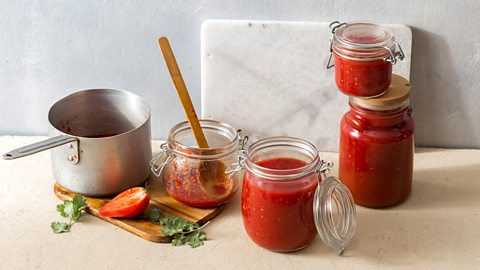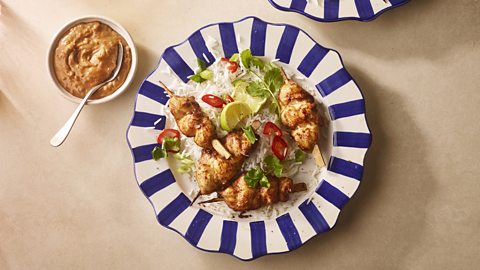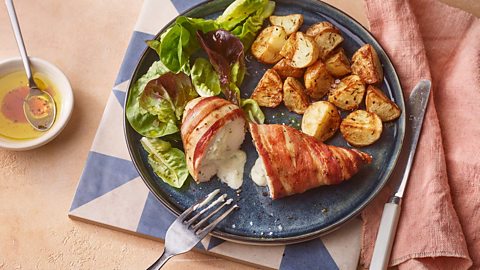What happened when I used AI to try and save money on my food bill
In a bid to spend less on my weekly food shop, I turned to AI to see if it could suggest cheap, nutritious and tasty dishes for me to cook at home.
By Laura Wingrove

Recently, the topic of AI has set up camp in my brain. The technology has been hurtling forwards at an exciting yet terrifying pace, prompting occasional middle-of-the-night worries it’s going to snatch the jobs that my family, friends and I need to pay our bills. Becoming ever-more sophisticated, it seems it’s not just human workers who it could be capable of replacing – even my cat Lomu might not be safe. (Don’t worry my little feline friend, I’m sticking with you. For now.)
Over the last few years, chatbots have been used for everything from therapy to job applications, with varying levels of success.
Always keen to try a food experiment, I decided to see if AI could help me reduce the cost of my food shop while still providing nutritious and tasty dishes over the course of five days.
It was nothing if not eye opening.
Setting the parameters
Me and my partner spend between £50 and £70 every five to seven days on groceries. This includes breakfasts, lunches and dinners and, more often than not, a few alcoholic refreshments.
While for the most part I eat a nutritious, balanced diet, I am also a food product developer’s dream customer. Jar of anchovy mayonnaise? Need. Cranberry and white chocolate bagels? Straight in my basket. I frequently return from the supermarket with an eclectic mishmash of ingredients, having lightened my wallet far more than strictly necessary.
So, I set out clear and concise parameters for my new chatbot pal, right from the off.
I needed a meal plan that would provide three meals a day for five days, for two people. It had to be healthy (including wholefoods) and filling. And it needed to cost less than £40.
I wanted the plan to be varied and interesting, thus satiating my appetite for novelty and helping to reduce our intake of processed, gimmicky rubbish.
‘Write me a healthy five day meal plan for two, costing less than £40’, I merrily typed into the text bar.
I don’t fully understand the intricacies of AI, but I’m now convinced it’s run by an obliviously out of touch health food enthusiast. All the key words and expected jargon featured; chia puddings, smoothie bowls and the holy grail of healthy dishes circa 2015; courgetti. I (politely) asked it to take another stab, ensuring the ingredients were vegetable, fruit, wholegrain and protein centric.
This time it offered up a more interesting menu. Something wasn’t quite right, though. Beef for £1? How was that possible? On further inspection, I noticed that all of the predicted costs seemed ridiculously low. Where was it getting its prices from, I asked? ‘USA’. Oh.
After another instruction – this time to use UK prices – it still missed the mark. The cost was based on the amount used, rather than the outlay for the entire product. What’s more, it didn’t make use of the leftover ingredients in the days that followed, making the meal plan both financially inaccurate and also wasteful.
I kept plugging away, tweaking each question and specifying requests, in a bid to find the magic formula. Finally, it curated the following meal plan.
Non avo toast
This healthy recipe swaps out avo for more economical frozen peas
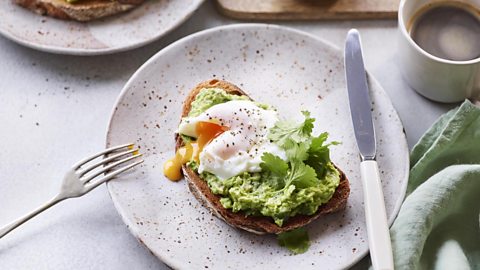
Breakfasts
Monday: Porridge with sliced bananas and a sprinkle of cinnamon
Tuesday: Greek yoghurt with mixed berries and a drizzle of honey
Wednesday: Wholegrain toast with avocado and a poached egg
Thursday: Veggie omelette with spinach, peppers and feta cheese
Friday: Homemade smoothie with frozen fruits, spinach, almond milk and a spoonful of peanut butter
Lunches
Monday: Chickpea salad with cucumber, cherry tomatoes, red onion and lemon vinaigrette
Tuesday: Quinoa bowl with roasted vegetables (such as sweet potatoes, courgette and peppers) and tahini dressing
Wednesday: Wholegrain wrap with grilled chicken, lettuce, tomato and hummus
Thursday: Mixed green salad with grilled prawns, cherry tomatoes, avocado and light balsamic vinaigrette
Friday: Lentil soup with a side of wholegrain bread
Dinners
Monday: Baked salmon with roasted asparagus and quinoa
Tuesday: Stir-fried tofu with mixed vegetables (such as broccoli, bell peppers, and carrots) served over brown rice
Wednesday: Grilled chicken breast with steamed green beans and sweet potato wedges
Thursday: Black bean and vegetable tacos with wholewheat tortillas, salsa and guacamole
Friday: Spaghetti squash with marinara sauce, sautéed mushrooms and a side salad
Satisfied with what looked like a well-balanced plan – albeit peppered with North American terms like oatmeal instead of porridge and zucchini instead of courgette – I requested it split my menu ingredients into a categorised shopping list, which it did without a problem.
The supermarket
Zipping around my local grocery shop clutching my phone, I spent no time in my beloved middle aisle, laser-focused on the task in hand. My neatly ordered shopping list made things extra efficient, too.
The whole shop came to an astonishing thirty-five British pounds. I couldn’t believe it! Mission accomplished.
However (you knew that was coming) my bags were lacking in the areas of snacks and useful flavour enhances such as spices and herbs, which dampened my excitement a little.
Cajun chicken with sweet potato
The bot’s chicken and sweet potato idea could be taken to new levels with this recipe
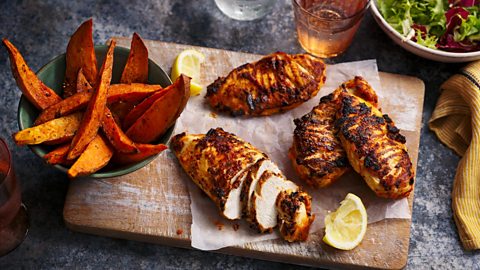
Time to cook
When it came to the ‘recipes’, the cheeky chatbot missed out some pretty crucial information. You know, like the method. Plus, there was no mention of seasonings, oil, cooking style, equipment or oven temperature. It pretty much just gave the descriptions of each dish, and it was on me to work out how to make them a reality.
So I filled in the blanks. No biggie for me as I like to experiment with dishes, but if you prefer to follow a step-by-step recipe or are perhaps a novice in the kitchen, this would be less than ideal.
The meals, while perhaps a touch unimaginative, did the job of being ‘healthy’ and were not unenjoyable per se, although this bot was clearly not concerned with evoking any feelings of excitement or enthusiasm with its menu.
That said, I grew fond of my new morning routine of getting up a little earlier to make eggs on toast or a filling smoothie (which certainly isn’t the norm). My morning mood improved and I wasn’t hangry by the time lunch came around.
Some dinners were better than others. The black bean tacos and baked salmon were decent ideas, but the squash and mushroom dish just wasn’t appealing by the time Friday night rolled around.
This would normally be about the time I broke out the menu for my local Chinese takeaway. Crispy beef and sweet and sour Hong Kong style chicken have me weak at the knees when I’m feeling lazy. The only issue? For two of us with rice, it comes to around £26.
So, could my AI advisor come up with an alternative and less spenny suggestion? Yes it could – and for just £7! Result.
Or was it? When I looked at the dish in greater detail I realised it was thoroughly underwhelming. I was presented with a rather lacklustre chicken and soy sauce stir-fry with carrots, peppers and mushrooms. No rice, no noodles, no crispiness and no fun. This definitely is not what I would consider an exciting healthy alternative.
I realise that healthy, cheap and fun are difficult concepts to combine in a recipe – but it certainly isn’t impossible.
Health matters
This prompted me to quiz the chatbot on what it considered to be healthy. Its answer? ‘Nutritional balance: A healthy recipe should include a balance of macronutrients (carbohydrates, proteins and fats) and provide essential vitamins, minerals and fiber. It should aim to incorporate a variety of whole foods to ensure a well-rounded nutritional profile.’
So I followed up with a question: ‘Why did you remove all substantial carbohydrates from my healthy Chinese?’, to which it replied, ‘I apologize for the oversight in the previous response.’
An oversight seems like a little bit of an understatement when giving nutritional advice to people. And a confusing one too, seeing as it accurately gave me the definition of a balanced meal.
It is broadly accepted that the internet is full of contradicting and inaccurate information. So how is an AI chatbot meant navigate the knotty nuances of health and nutrition information? Will it just end up perpetuating the restrictive eating we often saw in now-outdated health trends?
On reflection
It probably goes without saying that I ordered my favourite Chinese takeaway.
The dishes I ate for the rest of the week were totally fine: mostly good, but not great. Meals were relatively varied and filling but I did miss my snacks and I won’t say I didn’t have a pint or two on the side. Plus, this bot had no respect for Fridays, which usually demand a dinner with some sort of pre-weekend celebratory attitude as far as I’m concerned.
In terms of saving time, I don’t believe my little friend made anything quicker or more efficient, aside from creating a categorised shopping list. I had to feel my way through the cooking, making up the recipes myself, and source extra ingredients such as herbs and spices to add a bit of flavour.
And let’s not forget, the chatbot also needed a fair bit of coaxing to tease out the right answers. Specificity is key with this slippery little guy.
After a whirlwind week in a brand new bot relationship you’re probably wondering if we will go the distance. Will I forgo my chaotic food shops for the safety of AI logic? Well, I have taken some lessons from this encounter, for sure. For one, I’ve been reminded of the financial benefits that come with spending a little more time meal planning before heading to the shops.
But the chat bot and I have decided that it’s best to spend a little time apart. When it comes to nutrition, recipe writing and menu planning, I think I’ll be leaning on human experts for the foreseeable. Bots can’t seem to achieve the diversity and creativity that we crave in our meals (not to mention the expertise needed to guide us through a recipe). Luckily, my dog-eared, sauce-stained, human-authored cookery books do that very well.
Originally published June 2023
